The Martian Invaders Are Driving Oil Rigs?: An Ecocriticism of Science Fiction
By Remi Shaull-Thompson
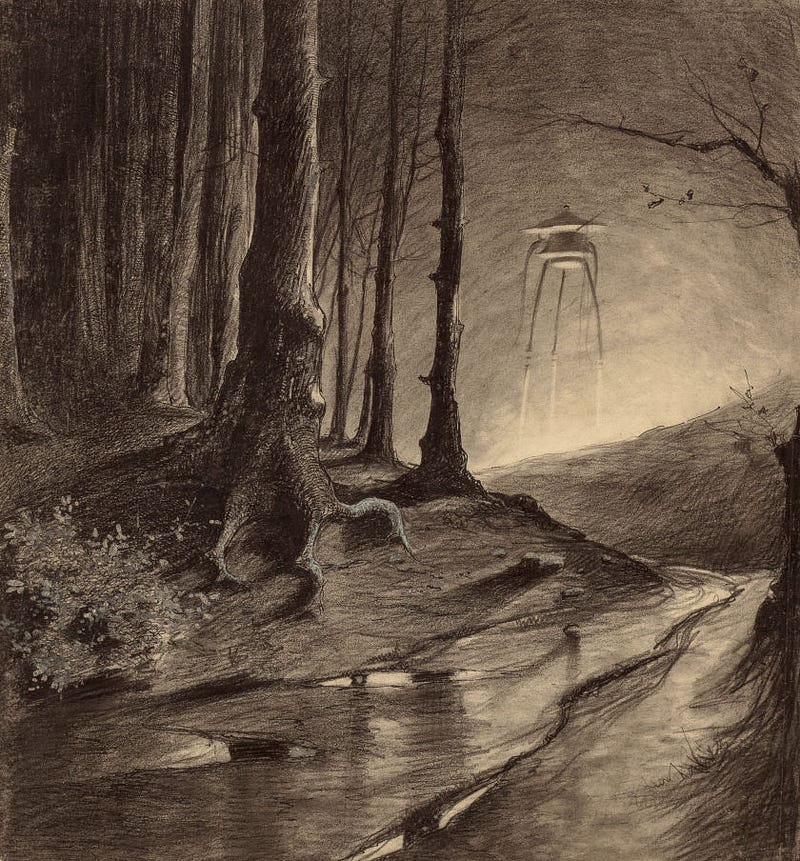
It might be hard to resist imagining, as you plop down with some popcorn to watch Christopher Nolan’s Interstellar, a more dazed Matthew McConaughey leaning out of his spaceship window to wink at you before blasting off in search of extraterrestrial chicks. Indeed, “they get older, I stay the same age” takes on a bit more of a tragic twist in the recent film — but, things still work out in his favor. Our actor leaves a ruined, starved, thirsty world in search of a new home. Through a mind-boggling series of events, he discovers an equation that will allow for a man-made planet to be launched.
Hollywood churns out science fiction movies about planetary apocalypse like clockwork. However, avoiding a debate about the film’s success, it is interesting that Interstellar’s apocalypse is not the result of zombie infection or alien invasion, but of the very real threat of climate change. Escaping a dead Earth is a common trope of recent blockbusters — Elysium, Oblivion, and After Earth, to name a few. But, response to ecological trauma has always been critical to the Science Fiction genre. “The arrogance of men is thinking nature is in our control and not the other way around,” says Serizawa in 2014’s Godzilla, and “humans are weak animals” says Serizawa in 1954’s Godzilla. In Sci-Fi, the old “man versus nature” thing becomes “man versus nature versus his own technology” and gives rise to the question, whose side are we on?
Analyzing Sci-Fi through an eco-critical perspective isn’t uncomplicated. Nature is a vast subject, and it cannot be generalized cross-culturally. In his 2014 essay defining the term ecocriticism, Greg Garrard points out that “not only is culture multicultural; nature is multinatural…the ecocritical community will need to develop new forms of deep, sustained and systemic collaboration to allow it to grapple successfully with the vast field of inquiry it has adumbrated.” And ecocriticism’s radical challenge, according to Helena Feder’s Ecocriticism and the Idea of Culture, “lies not only in recognizing other forms of subjectivity and the ecological interconnectedness of biologically diverse subjects, but in recognizing that the relations between them are political.” Thus, the practice of ecocriticism encompasses not only writing about the natural world, but also writing about wider political subjects like environmental justice, gender, and post-colonial studies. It calls for the creative and clarifying comparison of many literatures, fields, and histories. What types of metaphors and frameworks do writers use to comment on the complexity of political issues while making salient the disastrous and unjust realities of climate change and environmental destruction?
I believe that Sci-Fi provides important and fascinating answers to that question. First it would be useful to give some background examples of the role of fiction and the fantastical in environmental literature. In his essay “World-Economy, World-Ecology, World Literature,” Michael Niblett argues that an irrealist aesthetic prevails in places of social and ecological disruption. He speaks of Latin America, where traditional agricultural systems become replaced by exploitive capitalist flow economies. He suggests, then, that the magical realism genre emerges “where Caribbean peoples lack autonomous control over the production of nature, and hence over the production of social reality, this reality appears illusory or irreal since it is authored and manipulated by outside powers.”
I want to look also to the concept of the sublime, often present in nature writing, which traditionally described the transcendent experience of nature — the appreciation of its vastness, beauty, and power. Rebecca Solnit, in her book Savage Dreams, discusses the evolution of sublimity. She describes it in the Romantic period as a “taste for a violent, chaotic, overwhelming nature in the face of a relentlessly optimistic, productive…and industrial society.” She also turns to what she calls the “post-modern” sublime, a kind less associated with beauty and more with the unchecked power of “unnatural disasters”. She explains that, “The atomic bomb…is both the principal metaphor and fact of the problematic relationship between our power, desire, and limits…our morality is complicated by the fact that the sky above even the most demonic folly is often exquisitely colored.” So, where a sublime nature once effected humans to explore the vastness of their minds, or the ferocity of their emotions, the post-modern sublime turns instead to the effect of humanity on landscape, where the landscape is victim.
And, as Solnit says, “the sublime is a taste that lives on, in science fiction, and horror.” Sci-Fi is the intersection of human scientific, societal, fantastical, and technological imagination with a great wariness and critique of the very same imagination. So, with regards to ecocriticism, the most interesting theme that runs throughout Sci-Fi is a dialogue on the narrative of human progress through technology, especially as it relates to or harms the natural world. Indeed, Priscilla Wald, discussing the aftermath of Rachel Carson’s Silent Spring which called for an assessment of society’s blind use of harmful technologies in the name of progress, claims that “politics was finally catching up to science fiction, which had long depicted the disastrous consequences of humanity’s planetary violence.”
With this framework in mind, I am particularly interested in a classic work of science fiction, English author H.G. Wells’ The War of the Worlds (1898). This work depicts the technology of war and invasion. Martians, with their monstrous technology, become metaphorical of humankind, juxtaposed with the ultimately stronger forces of nature. This work provides context for a 2011 Sci-fi short story, English author China Miéville’s “Covehithe”. This story is monumental in its own right, with its commentary on our society’s dependence on oil. Yet, drawing parallels between the older and newer work highlights that the poisoning of earth today may be just as violent and horrific as actions everyone agrees must not be repeated, such as total war and use of chemical and nuclear weaponry. Such a comparison also highlights an evolution in humankind’s relationship with the progress of technology and with the natural world.
H.G. Wells’ The War of the Worlds
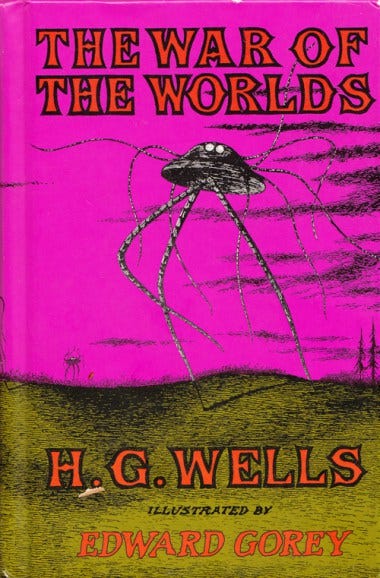
H.G. Wells was a hugely important figure in the establishment of the science fiction genre. Among his most enduring works is The War of the Worlds, a riveting portrayal of a Martian invasion of London and the surrounding area set in the beginning of the twentieth century. In the story, Martians attempt to colonize Earth as a replacement for their dying planet. They nearly succeed — as their weaponry is far superior to that of the humans — but are ultimately defeated by a bacterial sickness against which their bodies have not evolved defenses. The novel speaks to many anxieties and observations of the time in which it was written: chiefly, war, imperial competition, and the dangerous potential of new technologies.
In a 1920 Interview with Strand Magazine, Wells says that the origin of the story was a conversation with his brother, who said, “‘Suppose some beings from another planet were to drop out of the sky suddenly’…Perhaps we had been talking of the discovery of Tasmania by the Europeans — a very frightful disaster for the native Tasmanians!” And indeed, a critique of colonialism is present in the work — written during a time of heightened imperial competition and land grabbing. The Martians, Wells writes in the novel, “regard [humans] as inferior animals” and thus carry out their destruction without guilt in order to advance their own species. He makes the metaphor unmistakable, clarifying that we must remember what ruthless and utter destruction our own species has wrought, not only upon animals, such as the vanished bison and the dodo, but upon its own ‘inferior’ races. The Tasmanians, in spite of their human likeness, were entirely swept out of existence in a war of extermination waged by European immigrants.
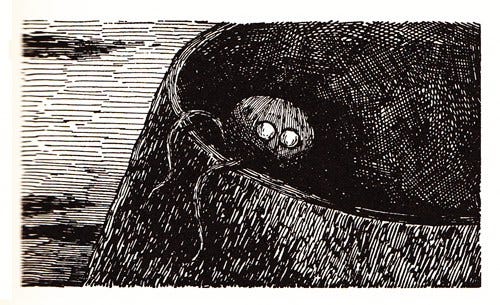
Here Wells does not hold back in his appalling depiction of imperialism as one that dehumanizes and destroys native beings and their right to life and homeland without mercy. Interestingly, he includes nonhumans in his description of the destruction of invasion, mourning the loss of animal life as well. In fact, much of the violence of the Martians is shown in its effects upon landscape: “In the centre sticking into the skin of our old planet Earth like a poisoned dart, was the cylinder.” The British homeland is referred to lovingly and broadly as “our old planet Earth”. But moreover, the Earth has skin — it is a living being. Meanwhile, the space ship is a manufactured cylindrical shape, already poisonous in its invasion of the living soil. Further, their Heat-Ray and Black Smoke seem to destroy and choke plants and animals. Indeed, a modern reader might draw parallels to our society’s dependence on fossil fuels, just as a late nineteenth century reader might draw parallels to toxic London smog, or even exhaust from war machines.
Wells novel came out in the midst of many other “invasion narratives”, in which a foreign army, often from Germany or France, invades the homeland of Britain. These books capitalized off a time of fear, as Martin A. Danahay explains in his edition of the novel, when “Britain was in industrial and colonial competition with these countries, and the invasion narratives expressed the anxiety that this competition would become outright war.” But, by making the invaders alien, Wells takes the fear of invasion one step further: as the British were to the Tasmanians, the Aliens are to humankind.
Furthermore, the alien’s execution of imperialism is bent not on the process of governing or civilizing, but literally on sucking all the resources out of the planet that it can. Thus, quite cleverly, Wells depicts the structure of imperialism as an environmental justice issue, ultimately a self-destructive practice —In Science Fiction and Empire, Patricia Kerslake argues that “the irony in this narrative is not that the imperial desire is inherently seeded with its own destruction but that the goal once achieved, is a lethal reward.” Due to the vampiric nature of the Martians, their survival on Earth is limited, since the natural resource of blood is limited — the Martians become allegorical of imperialist nations sucking other places dry of resources.
Additionally, in his article “The science fiction of H.G. Wells”, John Huntington points to the Artilleryman, a character who tries to convince the narrator that the human race has to survive and maintain its dignity, and eventually overthrow the Martians with their own weaponry. Huntington characterizes his speech as, “the triumph of man in the Artilleryman’s vision is not for humanity to enforce civilizing activity in place of Martian ruthlessness, but simply for humanity to become Martian. The irony is made all the more powerful by the naïve exhilaration of the passage.” Thus, Wells paints a greedy picture of human nature, and calls for a reassessment of the politics of land and resources.
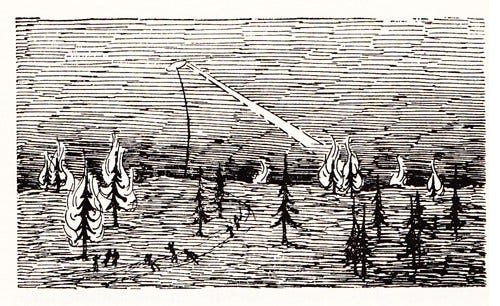
More than just an orgy of weaponry, the relationship between technology, power, and the organic is a critical narrative in the novel. In the same interview, Wells observes that “the conviction that history had settled down…was very wide spread…a few of us were trying to point out the obvious possibilities of flying, great guns, of poisonous gasses…making life uncomfortable if some sort of world peace was not assured.” And, surely enough, he was right about how such innovations would inevitably be put to use in horrible ways in the coming century. Accordingly, the novel introduces a hierarchy that includes both organisms and the machines they make. A horse is a “brute”, a human has many organs and a heart, but the Martians have evolved into creatures of intellect and dexterity, consisting solely of complex hands and enormous brains. Yet, the power and complexity of the Martian’s machines render even their bodies silly and useless in comparison. Indeed, the ultimate destination of the organic is to merge with the machine: the Martian machines move like living creatures: “so far as I could see,” the narrator says of a Martian device, “the thing was without a directing Martian at all.” In The Science Fiction of H.G. Wells, Frank McConnell points out that, for an author like Wells, fascinated by evolution, “Martians represent not just an invasion from space, but an invasion from time, from the future of man himself.”
An evolution towards unemotional and unforgiving intellect and power is one that transcends the organic to merge with the mechanical. But, this direction and hierarchy of man and machine is upended in two ways. First, when a lucky shot kills a Martian driving one of the tripods, the machine flounders and stumbles spectacularly, reduced to rubbish without its driver. There is a brilliant moment when the narrator thinks the machine will simply keep going on its own — before the disillusionment of its collapse. Second, the novel’s climax happens when the narrator discovers that the Martians and their Red Weed are killed off, not by the weaponry of man, but by a bacteria they have not evolved to resist. This turn is an insistence upon the contrast between natural evolution and the sentient evolution of society and technology. Prior to the bacterial infection, the idea of progress was linked to human innovation — yet, technological and societal superiority was measured based on the ability to destroy and conquer. The Martians, with their huge brains, were able to invent such technology, but were disconnected from the realities of the body and nature. Hence, Wells laments that science and progress is made only towards destruction, and not towards protecting ourselves from the true antagonist: the harsh realities of nature, and the inevitable death of our planet. It is likely that the Martians will not have success on other planets, and should have worked harder to save Mars instead of inventing weapons. As the narrator warns, “we cannot regard this planet as being fenced in and a secure abiding-place for Man.”
China Miéville’s “Covehithe”
The Martian machines were fantastic and impressive because they gave the illusion of animation, of functioning independently without an operator. But, the novel broke this illusion: the Martian machines stumbled and fell without their driver, nor did their machines protect them against Earth’s simplest organisms — and thus the formidable technology was subject as well to the vulnerability of the organic body and awesome power of nature. Thus, The War of the Worlds commented on the importance of humility and sustainability for the future of technology and the mindset of civilization itself. China Miéville’s short story “Covehithe” additionally asks the question: does our technology actually have a mind of its own? What if, after the Martian died and the tripod crashed, the tripod had taken matters into its own hands and had picked itself up again, fully animated?
In “Covehithe”, the remains of sunken oil rigs come to life, living under the ocean and coming onto land in order to lay their eggs. In the present, the narrator Dughan brings his daughter to watch a rig lay its eggs in the British town Covehithe, before they are apprehended by security guards — the rigs are protected from harm and kept under close watch. However, interjected into this story is the narrator’s retelling of his time as a soldier, destroying the first rigs that emerged. The first rig showed up in Canada, and subsequently many more came up, in the Gulf of Mexico, Nigeria, and eventually in Covehithe — a trajectory that takes us from the places that have incurred much damage from oil extraction, to a country that has and will see secondhand destruction from the burning of fossil fuels as water inundates its coastlines. It would not be farfetched to claim that Miéville was inspired by The War of the Worlds: he describes the oil rigs as “tripods” that “staggered like a crippled Martian out of the water.” Thus, Miéville’s story is a modern extension and complication, inspired by Wells, of the relationship between man, machine, and nature.
To begin with, the landscapes of “Covehithe” are important in the story’s development — nature is a character, it acts upon the plot. The town of Covehithe is located on the English coast, and has historical ruins. The coastline is rapidly eroding in this area, and the town is expected to crumble way within 30 to 40 years, according to a 2010 BBC article. Although the coast has long been subject to erosion, “due to rising sea levels, erosion risk management is a priority.” As father and daughter walk towards the sea, nature is wrong: the air smells, strange lights shine through leafless trees, and the soil is oily to the touch. “This close to the waves,” says the daughter, “the land felt…misbehavicious”.
When they come to a spot where the road has eroded, ending abruptly at a cliff, Dughan explains, “‘The sea’s taking it all back’…‘Is it still going?’ she said…‘Being eaten?’ Dughan shrugged.” In the later quotation, the grammar and vocabulary Dughan uses makes the sea into a character, a violent one that eats at the road and cliff. The former quotation also demonizes the sea, as proximity to it kills off plants and intoxicates the land. But, it’s not quite demonizing. The sea is “taking it all back”, almost as if the sea were taking revenge for something we have done to it. Dughan seems to suggest that we have turned nature against ourselves — even putting it in conflict with itself, as the sea eats the land, and the land becomes “misbehavicious”. Thus, the nature in “Covehithe” is just as violent and powerful as in The War of the Worlds, but it is also unnatural — it is self-destructive.
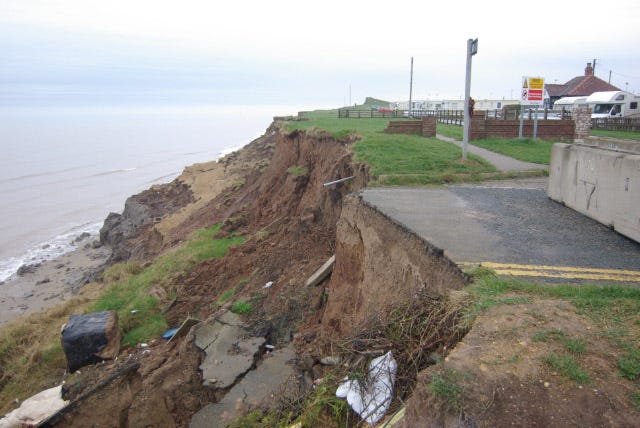
Why would the nature turn against us, itself? Perhaps because in “Covehithe” the oil rigs that poison and upset nature end up under the care of humans, instead of the other way around. In the story, the description of the destructive rigs quickly turns pitiful. In The War of the Worlds, the science and technology is not the problem, merely that it is being used for nefarious purposes. It is progress towards conquering and an ignorance of natural realities, not the pursuit of knowledge and technology itself that gets the Martians — hence, their technology, though flawed, is sleek, impressive, and desirable. In contrast, the technology of “Covehithe” the technology of the non-renewable capitalist economy is lumbering, leaking, and entirely unredeemable. It speaks to a disillusionment with the goodness of technology after a century of chemical and nuclear weapons, and machines that tear up and pollute the earth.
The genius of this work, however, is that these ungraceful, inhumane machines are, it appears, conscious. They lay eggs, walk about on the sea floor, and will go on to evolve and life a life of their own. In The War of the Worlds it was feared that Martians would replace humans. In “Covehithe” the agency and life of technology has already conquered human capacity to understand or control it. Thus, the story asks us to contemplate the predator that we have created, and how it upsets the balance of nature and our control over our own future. What both The War of the Worlds and “Covehithe” agree on is the danger of assigning attributes of the living, or feeling empathetic for machines. In The War of the Worlds, nature is stronger than any human technology or civilization. “Covehithe” introduces the anxiety that the technology we have wrought might actually inundate and conquer natural systems.
In the end, what does Miéville accomplish by bringing oil rigs to life? Miéville is not suggesting that our technology might get so advanced that we lose control of it. Instead he worries that we might already have become so dependent on technologies harmful to our land and fellow beings that we will not be able to extricate ourselves. Perhaps even that if we do not change soon, the damage we are causing to our ecosystems will be too great to curtail — in the most apocalyptic of interpretations that the technology we have made will be the only “beings” that survive us.
Yet, maybe his most critical and important note is that the humans in the story do not want to eradicate the rigs, they protect them — that is, instead of recognizing that oil is a broken system that creates monstrosities of human folly, many in elite countries and positions want to preserve and revive the old economy and system as if it were an endangered species. So, the story’s ending speaks clearly to this madness Miéville seeks to impart. His daughter asks if he thinks it is true that the rig killed a dog, or if the officer was just lying to scare them — at this point everyone seems happy and in awe of the rig. On the other hand, Dughan, “stared not at the twitching Petrobas P36…injecting slippy black eggs into England, but at the sea”. Dughan is keenly aware of the danger the rising sea presents, and how the rigs have not only poisoned it but killed many people. Thus, Miéville uses the protection of the mother rigs as a metaphor for people who protect toxic oil for its ability to produce more and more comfort, infrastructure, and money. His metaphor is one of disgust for a society in which oil’s production of money is valued more than securing a future where living beings can raise their young in a clean landscape.
Conclusions
In these stories, the dangers of the technologies of non-renewable energy and war are shown to have disastrous effects upon nature and society — but instead of a realist depiction of such dangers, these works of science fiction condense environmental harm into monstrous figures which wreak havoc on landscapes. Yet, what makes monstrosity and the apocalyptic worthwhile is that the monsters come across to the reader as eerily human, allowing the authors to imaginatively represent complex societal issues in creative, shocking ways. Sci-fi allows for a figuring of violence which might not be apparent in everyday life, but which is the product of everyday life.
Additionally, it is important that these authors, both English, hint at the interrelatedness of environmental harm with imperial and social systems in their works. They acknowledge and lament the unfair violence performed by the Global North on the Global South. But, by showing an invasion of environmental violence upon England, they hint at the future of environmental harm which will affect all corners of the world — thus the irony of self-destructive technological progress is central to both works. Hence, through the pervasive lens of environmentalism, both call for a restructuring of priorities regarding the trajectory of technology and civilization.